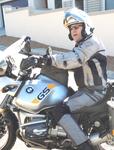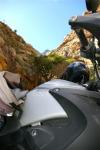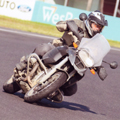Grondpad ry
Ons kan baie tegnies raak op hierdie onderwerp, en in die proses word baie semi-waar en semi-onwaar fisika voorgehou as die finale feite. Bv, as die sakkie sement op die pegs le^ is die swaartepunt wel lekker laag, maar in werklikheid is 'n mens soos die sakkies sement wat op twee lang pale op die pegs staan (maw die sakkies sement is selfs hoe"r as die sakkie sement wat op die saal le^) En dan kom traagheid ("inertia"), traagheidsmomente en versnelling ook nog by...
Dit alles is tegniese dinge --- en ver van jou gedagtes wanneer jy wind in jou gesig voel en stof in die spieels sien --- staan is lekker, en jy kan die bike beter beheer, en jy en die bike "gesels" met bene en gewigverplasing.
Belangrik is dat mens se bene "sag" is en jou lyf se gewig (massa!) isoleer van die bike s'n. En jy kan die bike en jou eie massamiddelpunt relatief tot mekaar skuif, tot voordeel van julle albei. Met sit is jy en die bike een groot massa, met min buigsaamheid. En jy skud jou longe uit op rowwe pad. Dis nie verniet nie dat ons geleer word om te staan-ry. Dis 'n beproefde tegniek en kom al baie jare. Die tegniese redes/verklaring is miskien interessant, maar die resultaat is wat regtig belangrik is. (soos daai advertensie gese^ het: ...it's not whats inside, it is how you get it out...)
Vir meer oor CofG en swaartepunt ens, sien hierdie skakel:
http://www.bmwmccc.org.za/whats-all-look-stuff-anyhow
Yes Neil, you are very correct - the standing/sitting/CoG issue is a case of forces at play, interacting. Different forces dominate in different situations, and the situation continuously changes as you and the bike moves forward, sideways, etc. We can debate it up and down ad infinitum. Fact of the matter is that it is a ''interplay of forces'' (static, dynamic, inertia, gyroscopic etc etc.) The CoG is but one (mathematical) characteristic that is usefull in the bigger picture. Standing is a proven way of controlling the bike in difficult terrain. Lets practice it more and debate it less. :)
------------------
Some food for thought from another thread...
(http://www.bmwmccc.org.za/whats-all-look-stuff-anyhow)
Centre of gravity is but one of many aspects involved in the sit vs stand issue.
Many instructors (and DVDs) seem to be using the wrong wording in their explanation re sit vs stand. In the process many many riders get confused.
Yes, I remember very well how Niel Terry once explained it - maybe poetic but perfectly correct!
What is much more important are the inertia forces and where/how they actually interact.
(inertia is the force experienced when a mass is accelerated or is being retarded).
Yes, mathematically the inertial forces act through the Centre of Gravity, but that is one of many aspects to consider in the issue regarding handling/response of a bike.
I made some pictures that could help, in a simple way, to show
a) that total CoG is higher when standing
b) the effect of inertia forces when rider is seated vs standing
c) Where forces act is not the same as where CofG act
First pic: The total CofG (bike plus rider) is higher when standing.
Second pic: Effort for sideways movement is dictated by the mass that needs to be moved and where it interacts. Seated: about 300kg needs to be moved, requires more effort, response is slower. When standing, less mass (~220kg) is moved, less effort is required and response is quicker.
And for good measure, a picture to show the points where forces (not CofG!) interact. This is where lots of confusion is caused. Forces and CofG are different entities and should be used in correct context.
:)
Hi julle , ek luister lekker na al die raad en ervaring wat hier gedeel word, wens ek was daar om te kon rondrits op die gronpaaie in die mooiste Kaap
Hi BM-ers
I would like to hear what the concensus is out there without starting a mud slinging match.
I had a 1150GS and sold it because the bike was way to intimidating for me. I would like to get back into biking, possibly more touring with the occasional Swartberg pass and similar.
Can the RT actuall do this without danger to myself and or the bike?
On one intro to offroad pillion course I did, there was a fellow on an old RT. He did a fair amount of dirt road riding - but the RT would not allow him to turn off the ABS. This is a deal-breaker - it means you cannot do an emergency stop. He failed the course as a result.
One way to stop being intimidated by your bike is to do some adventure bike training (advertisers on this site). One of them has the slogan "Double your skills and halve your fears", with many trainees exclaiming that their bike now feels smaller to them. I would get a GS - the 1200 is not as heavy as the 1150 - and the 650 is a lot smaller yet still punchy (but not as great for touring). The 800 has its lovers and not so lovers.










